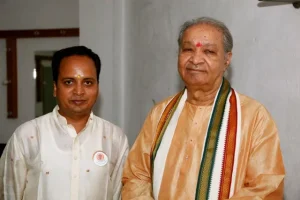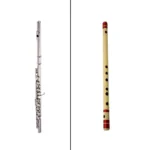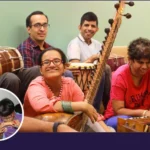“I was blind because of the dense darkness of ignorance; my eyes were opened by the Guru with the collyrium of knowledge.” My prostrations unto Him! Words can never express the greatness of the Guru and the Guru-shishya parampara. This parampara is above all boundaries and limitations.
The culture of Bharat (India) is extremely diverse and phenomenally integrated. It is a fascinating revelation for people who are unaware of this deeply-rooted culture in depth. The etymology of Bharat in Sanskrit is ‘Bha’ – the light of knowledge, and ‘Rata’ – revelling. So, Bharat means “constantly revelling in knowledge”. The distinctive cultural heritage of a country gives it the identity of a nation.
In all the knowledge traditions of our nation, the teaching-learning process is verbal. In the most revered way, it is called ‘Guru Mukhi Vidya’, where the knowledge is received directly from the mouth of the Guru, not merely from textbooks. This ancient tradition is extremely widespread in one of the innumerable cultural traditions of Bharat – The Classical Music Tradition – Shastriya Sangeet Parampara. It is as profound today as it was thousands of years ago, constantly infusing faith in the mind and heart of all seekers of music, inspiring them to choose classical music as their way of life.
The Seeker’s Journey
There is an eternal question: How does a person choose music as his/her way of life? Is it the person who chooses the music or music which chooses the person? Legendary belief is that when the person is ready, music chooses the person to retain its eternity. Being intensely aware of the mysterious path of music and the unpredictable nature of life, the seeker treads the path of music in a divine choiceless synergy.
The seeker/student of Classical Music listens to various recordings, goes to different concerts to listen to great musicians. He gets the inspiration to delve deeper into the ocean of music and practices with whole-hearted dedication to find his own ‘Self’ through the music. During this mystical quest, he meets a person who is remarkably different from others, unique in his approach, who has a distinctive style of music, and who has travelled a long way in his/her musical journey.
The seeker responds to this special person with an intuitive and immense admiration, love and reverence and wants to surrender himself completely at his Lotus Feet. He wishes to serve him and yearns to know the deeper and finer elements of music. In short, the student accepts him/her as his ideal, his Guru.
One fine day, the student gathers courage in his heart and approaches the master to seek acceptance as his shishya. Seeing his sincerity, eagerness and devotion, the Guru blesses the seeker and accepts him as a part of his close inner circle of students.
Now comes the real test! The student has to leave everything else, sometimes even his hard-earned techniques and style of playing or singing, to start a new journey. Now, for the student, the Guru is his friend, his parent, his source of knowledge, his secret fount of inspiration – his everything! By living in close proximity with the Guru, the student starts acquiring the values of the Master and tries to apply them in his life.
The Soul of the Svara
Understanding the svara is a journey by itself. The living legends say there is an outer circle, as well as an inner circle of the svara. Through continuous sadhana, when the student is prepared and his mind is calm and quiet, the svara envelopes the seeker and sucks him into its inner circle. This is the time when the student has direct experience of the svara. In spiritual terms, this experience is referred to as ‘Aparoksha Anubhooti’.
“Svayam rajate iti svarah” – svara is self-shining. It is not just the quality of the sound, the true pitch, or tonal beauty; it is a presence – the very substratum of the entire creation. The Master advises the student to redirect his entire sadhana to understand and know the svara. He indicates that “it is not difficult to learn the rules and elements of ragas, but to acquire the svara, one needs to do intense riyaz, sadhana, and naada-upasana.”
Now, the journey is within – it is a spiritual journey. This is subtler and draws the seeker further inwards. It is said that to know the svara, one needs to practise ’Musical Brahmacharya’, eschewing all other attractions. The student gives up all physical comforts, isolates himself from the influence of the external world and dedicates himself with single-pointed concentration to svara sadhana. For years, he continues his sadhana with invaluable support from his Guru.
As he continues his sadhana thus, the student begins to pulsate with music and finds every cell of his body reverberating with svara. They say, “The raw clay has started taking the shape of a pot.” His thinking, his attitude, his behaviour, and his personality change, thereby making him an entirely different person. This spiritual transformative experience is natural in Indian classical music. The great masters of Indian music, like Swami Haridas, Tyagaraja Swami, Pt. D.V. Paluskar, to name only a few, lived a divine and saintly life.
Music as a Way of Life
Now-a-days, teachers of music are available in plenty, but only divine grace can lead us to a true Guru. Divine grace descends, drawn by the great merits of the seeker’s love and single-pointed devotion for music. It brings him closer to the Guru who will guide him to the higher dimensions of his art.
It is not just a student who finds his Guru, quite often the Guru finds his disciple! In this parampara, the Guru does not merely teach the rules, elements, and aesthetics of the ragas, but he helps the disciple to unfold his own music. The Guru takes great care that the student should not merely copy or imitate him; he helps the student to find his own identity and develop it. One of the best examples is that of Ustad Allauddin Khan Sahib. All his disciples, like Ustad Ali Akbar Khan, Pt. Ravi Shankar and Pt. Nikhil Banerjee, are very different from one another, but each one is a legend in their own respective field.
It is not just the knowledge, technique, style or aesthetics of music which are transmitted in the Guru-Shishya Parampara, but a whole range of values, perception, vision, and indeed, a way of life.
Once again, I prostrate at the lotus feet of the exalted Masters and salute the great parampara, which stands as a beacon, lighting the path of seekers of Music and transforming them into Musicians!




